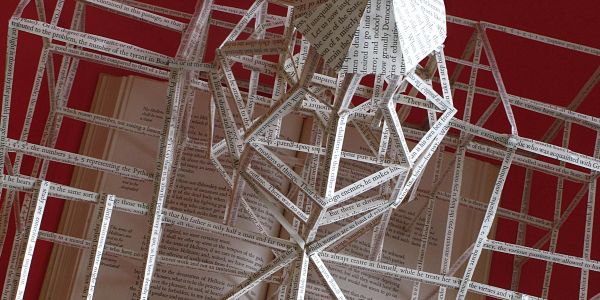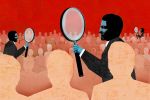Over the past two decades in the United States, there has been a new wave of criticism of higher education. Much of it has condemned the rise of "academic capitalism" and the corporatization of the university; a substantial wing has focused on the deteriorating conditions of academic labor; and some of it has pointed out the problems of students and their escalating debt. A good deal of this new work comes from literary and cultural critics, although it also includes those from education, history, sociology, and labor studies. This wave constitutes what Heather Steffen, a graduate student in literary and cultural studies with whom I have worked at Carnegie Mellon University, and I think is an emerging field of "critical university studies."
Often criticism of the university seems a scattershot enterprise. A scholar from almost any discipline might have something to say about higher education, but it's usually an occasional piece that's a sideline from normal work. There is, of course, a sizable body of scholarship coming from the field of education, but it largely deals with elementary and secondary schooling. Or it follows established scholarly channels; for instance, it might gather and present data about the student body, or it could deal with administration, or fill in a segment of the history, sociology, or financing of education.
In contrast, this new wave in higher education looks beyond the confines of particular specializations and takes a resolutely critical perspective. Part of its task is scholarly, reporting on and analyzing changes besetting higher education, but it goes a step further and takes a stand against some of those changes, notably those contributing to the "unmaking of the public university," in the words of the literary critic Christopher Newfield.
To give it a name recognizes that it has attained significant mass and signals a gathering place for those considering similar work. "Critical" indicates the new work's oppositional stance, similar to approaches like critical legal studies, critical race studies, critical development studies, critical food studies, and so on, that focuses on the ways in which current practices serve power or wealth and contribute to injustice or inequality rather than social hope. "Studies" picks up its cross-disciplinary character, focused on a particular issue and drawing on research from any relevant area to approach the problem. "University" outlines its field of reference, which includes the discourse of "the idea of the university" as well as the actual practices and diverse institutions of contemporary higher education.
Critical university studies is not only academic. Part of its resonance comes from its organic connections to graduate-student-unionization and adjunct-labor movements. That is probably one reason that it draws literary and cultural critics, because those in English and foreign-language departments typically do a great deal of introductory teaching (rather than, say, working in a lab or under one professor on a particular project financed by grants) and lead union efforts.
In my view, critical university studies emerged in the 1990s, as scholars began realizing what was happening to higher education. (In the 1980s, influential commentators like William G. Bowen were still predicting rosy prospects for the 1990s.) The approach was first suggested in books like Lawrence C. Soley's Leasing the Ivory Tower: The Corporate Takeover of Academia (South End Press, 1995), Bill Readings's The University in Ruins (Harvard University Press, 1996), and Sheila Slaughter and Larry L. Leslie's Academic Capitalism: Politics, Policies, and the Entrepreneurial University (Johns Hopkins University Press, 1997), all of which analyzed the consequences of "technology transfer" to businesses and the rise of corporate managerial policies in place of traditional faculty governance.
In the 2000s, critical university studies coalesced with work like David F. Noble's Digital Diploma Mills: The Automation of Higher Education (Monthly Review Press, 2001), Jennifer Washburn's University, Inc.: The Corporate Corruption of Higher Education (Basic Books, 2005), Joe Berry's Reclaiming the Ivory Tower: Organizing Adjuncts to Change Higher Education (Monthly Review Press, 2005), Marc Bousquet's How the University Works: Higher Education and the Low-Wage Nation (New York University Press, 2008), my own "Debt Education: Bad for the Young, Bad for America" and "Student Debt and the Spirit of Indenture" in Dissent magazine (Summer 2006; Fall 2008), Newfield's Unmaking the Public University: The Forty-Year Assault on the Middle Class (Harvard University Press, 2008), and Michele A. Massé and Katie J. Hogan's Over Ten Million Served: Gendered Service in Language and Literature Workplaces (State University of New York Press, 2010).
As many of those titles indicate, this work focuses on the consequences of corporate methods and goals, like corrupting research and increasing managerial (as opposed to academic) control, cutting labor through reducing regular faculty positions (while increasing adjunct positions), and exploiting students by requiring them to work more and take on more debt. Many of these analyses debunk commonplace views—for instance, that research supports other parts of the university. Rather, Newfield shows, research often occurs at the expense of teaching, especially in the humanities. Or they debunk the idea that the university has a benevolent relationship to students; rather, graduate students are frequently used as cheap labor, and undergraduates are captive objects of exorbitant banking profits.
Another dimension of critical university studies occurs in new media. Perhaps more than through their books, Bousquet and Newfield have gained influence through their blogs, Bousquet at How the University Works and The Chronicle's Brainstorm, and Newfield at Remaking the University, which is a key clearinghouse for information, particularly for higher education's struggles in California. In addition, new media has provided a readily permeable channel among critics around the globe, for instance, under the auspices of the Italian-based international collective, Edufactory, which features radical solutions to current problems.
In some ways, critical university studies has succeeded literary theory as a nexus of intellectual energy. A dominant tenor of postmodern theory was to look reflexively at the way knowledge is constructed; this new vein looks reflexively at "the knowledge factory" itself (as the sociologist Stanley Aronowitz has called it), examining the university as both a discursive and a material phenomenon, one that extends through many facets of contemporary life.
Critical university studies especially evokes critical legal studies because they both scrutinize central social institutions, and a comparison of the two gives a fuller sense of the new field. Critical legal studies, or CLS as it is often known, began in the late 1970s and became established during the 1980s among a group of American legal scholars who wished to show that the law was not neutral or impartial, but served dominant social and economic interests. In a similar way, critical university studies, CUS, turns a cold eye on higher education, typically considered a neutral institution for the public good, and foregrounds its politics, particularly how it is a site of struggle between private commercial interests and more public ones.
Another similarity is that both fields argue against academic practice as usual. Critical legal studies distinguished itself from standard legal history, suggesting that law was an instrument of its social structure, therefore serving the interests of propertied classes, as well as tried to find ways that law might contribute to more equality. Critical university studies distinguishes itself from the standard history of education or the palliative tradition of "the idea of the university," which projects an ideal image, and analyzes how higher education is an instrument of its social structure, reinforcing class discrimination rather than alleviating it.
In theoretical terms, critical legal studies grew out of a realist rather than idealist orientation, studying how the law operates in practice. It emphasized what the legal theorist Mark Kelman calls "law in action" over "law in books." So, too, does critical university studies analyze the concrete instances and uses of higher education. One note I would take from Kelman is that we might call critical university studies "criticism in action" or "theory in action." It draws on the insights of contemporary theory but connects them to the institution under our feet.
The differences between CLS and CUS also help define the latter. The legal-studies movement was formed primarily from the 60s generation and reflected some of the concerns of the civil-rights and antiwar movements. Developed by those largely from the succeeding generation, university studies is a response to the draining of social institutions since the 1970s, resulting in what I've called the post-welfare-state university, when public rights to education and other social services established after World War II have been shaved back. Critical legal studies grew out of a critique of complacent midcentury liberalism, whereas critical university studies is a critique of neoliberalism and the conservative ascendency.
Both assume not merely an academic but an activist dimension—but come from different places. Critical legal studies usually came from those at elite institutions, notably Harvard and Yale Universities, and desired to change policy top-down through legal education. Critical university studies comes from people at a range of institutions, for the most part from public colleges and universities, and a variety of positions, and desires to change policy through direct action in unionization or the various ideas to reform student debt, as well as in reportage, analysis, and policy proposals.
And it has had effects, beyond the ivy, in recent student-protest and faculty movements in California, in Oregon's CORE faculty-student advocacy group, and in the Occupy Student Debt Campaign, on which I have consulted and on which the cultural critic Andrew Ross has worked. Critical university studies provides the factual and intellectual ballast for such campaigns.
There are two views of the history of critical university studies. One emphasizes its continuity with a tradition inaugurated in the 19th century, or before, in America. Steffen leans toward this view in her dissertation, "Intellectual Proletarians in the Student Factory: Criticism of the University, 1900-1930," which highlights figures like Upton Sinclair and groups like the League for Industrial Democracy. Indeed, Sinclair's 1923 The Goose-Step: A Study of American Higher Education was the magisterial muckraking report on universities of its time and indicts the ways in which they were byproducts of the fortunes and whims of the great robber barons.
The second view emphasizes the field's specificity to our time. I favor this more presentist orientation: While critical university studies might have forebears like Sinclair, and while we might draw inspiration from them, it is distinctive in arising from and responding to the vast octopus of contemporary higher education and the current trend toward privatization. Think of this analogy: One could speak of the university as continuous, for instance of Harvard from its founding in 1636 to now, just as one could speak of Procter & Gamble as a continuous entity. However, there is a vast difference between the small shop of Procter the candlemaker and the corporate octopus of Procter & Gamble, a difference that is puttied over when we speak of it as continuous.
The current university is discontinuous simply in terms of size, with its huge real estate and other holdings, unimaginable in the previous system, and with its huge student body and faculty. In 1899-1900, according to the National Center for Education Statistics, there were 23,868 faculty in degree-granting institutions. In 1999-2000 there were 1,027,830. Likewise, students increased from 237,592 to 14,791,224 in the same period—a factor of almost 63 times, whereas population rose slightly more than 3.5 times. The university is a hub institution of our time, touching the lives of almost every American, reaching them as students or through any of its other spokes.
Over the past few years, the conditions prompting our investigation of the university have become even more urgent, as there have been greater decreases in public support, more pressure on selling off parts of research to businesses, more casualization and speed-up of faculty labor (adjunct positions and heavier work loads), and regular increases in tuition and subsequently student work hours and debt. There is thus a pressing need not only to diagnose what's happening but also to oppose changes that go against the public interest and to propose policies that might strengthen higher education. We need a strong critical study of the university—especially now.
Critical university studies has a full slate of work continuing, but one task that I think will take on more importance in the next few years is investigation of the globalization of higher education, which is promoted as altruistic but is often actually a profit-seeking endeavor through which American or European universities sell their brands and services. For instance, my own university has recently agreed to a partnership with the Rwandan government to provide graduate engineering programs in that country. That met with controversy because of the human-rights abuses of the Rwandan regime that signed the deal. While understandably troubling, however, the controversy obscured a fundamental problem. Even if Rwanda were an exemplary state, the deal seemed foremost a cash transaction: Carnegie Mellon receiving $95-million. The university operated as any profit-seeking company would—which is good for its balance sheet, but is that the role of a university? Moreover, rather than gaining a niche for our institutions in underdeveloped regions, shouldn't the goal of such an exchange be for Rwanda to develop its own universities?
Within critical university studies, there are some early efforts at exploring what Ross has called "the rise of the global university," such as Edufactory and some British-based scholars who have advocated "critical higher-education studies." We in the United States might explore comparative frames more than we have so far, looking to Europe, where countries typically provide greater support to higher education but are now experiencing changes similar to those befalling American institutions, as well as to the gold rush of major university brands moving into the Middle East, Asia, and Africa.
Another task is closer to home and more modest: We should incorporate issues about higher education into the curriculum. Through the 1990s, Gerald Graff, a professor of English, urged us to "teach the conflicts," in his book by the same name. I would amend that to "teach the university." Graff was responding to the culture wars of the late 1980s and early 1990s and trying to turn them to productive use in pedagogy. One problem, though, was that "conflict" is finally an amorphous category that might apply to Holocaust denial as well as anything else. "The university" provides a content, one that has immediate relevance to our students in their own lives, as well as to their understanding of our society. It bears on substantive questions about citizenship, the idea of the public, and the humanistic tradition.
One might teach a course on the university in a variety of departments, including literature, media, history, sociology, and even business, and such a course naturally lends itself to an interdisciplinary range of readings. It prompts students to look at the connections among American history, ideals, and narratives; it also provides a test case for debates over political and legal theory, from the U.S. Supreme Court decision of 1819 that not only established Dartmouth College as an autonomous entity, but also the legal status of corporations. One might also draw on sociological data, business reports, and policy debates for students to research and argue about.
I teach in an English department and have seen such a course put to good use in freshman writing classes, opening students' eyes as well as engaging them, and introductory literature classes, where they might study fiction as well as some theoretical and historical context. It could also be an excellent graduate seminar in which students might develop research projects in many fields, be they literary history (for instance, on the academic novel) or labor history (for instance, on graduate student labor).
While those of us affiliated with critical university studies tack to a progressive ideal of free and open public education, teaching the university does not presuppose any political position. Instead, it puts the issue in front of students for them to question, investigate, and judge. After all, they are not only the subject of higher education but will soon be our citizenry, so they might more knowledgeably decide what system they want, how it might promote an enhanced public life, and how it might contribute to the flourishing of those who pass through its classrooms, quads, and online portals.
Jeffrey J. Williams is a professor of English and literary and cultural studies at Carnegie Mellon University. He is finishing a book called Brave New University and elaborates his plan to "teach the university" in Pedagogy (Winter 2008).








